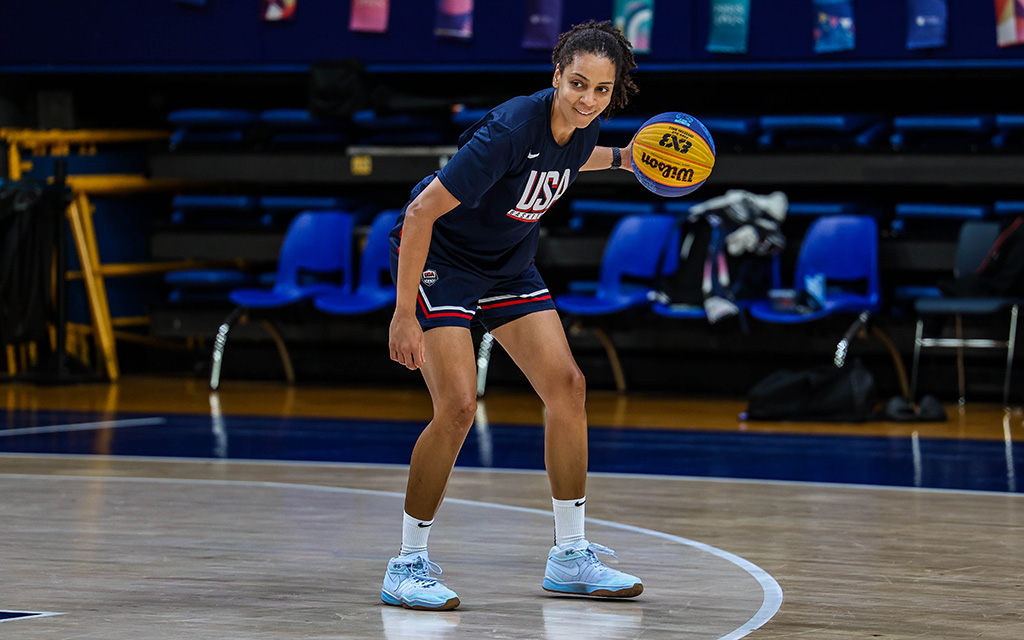PARIS – Cierra Burdick has a long and successful history with Team USA, yet she is in the middle of her debut at the Paris Olympics and is serving as the veteran for a 3×3 team on its quest for a repeat title.
Burdick, 30, says her preparation for a different version of the sport does not change. The former Phoenix Mercury forward fell in love with basketball at an early age and still loves it.
Her international footprint started all the way back when she appeared on the 2009 USA U16 national team, winning a FIBA gold medal in the process. Since then, she has appeared on many international 5×5 and 3×3 teams throughout her career, winning six gold medals in total and capturing other tournament titles.
“I didn’t know what my ceiling was going to be,” Burdick said. “I knew my chances of making the 5-on-5 roster were probably slim, but 3×3 came on the circuit and I really fell in love with it.”
During Burdick’s hiatus from Team USA from 2015-2019, she was drafted by the Los Angeles Sparks but started her career with the Atlanta Dream. She played five seasons in the WNBA, including a short stint with the Mercury, and has since moved to international basketball like many of her peers.
Burdick calls her journey a “roller coaster” with many ups and downs, but she wouldn’t trade it for anything in the world.
She has since proven to be an invaluable player in 3×3 competition, a sport that debuted in the Tokyo Olympics. She has played often and won tournament titles since her debut in 3×3 competition in 2014.
“It’s incredible. I’ve been part of USA basketball since almost half of my life,” Burdick said. “A lot of the staff members have seen me grow up. So this is family.”
Team USA 3×3 women’s basketball coach Jennifer Rizzotti coached Burdick in 2011. They won a gold medal together and helped the team land the title of USA basketball team of the year.
“From what I remember of 2011, she was one of my favorite players to coach,” Rizzotti said. “I felt like she had leadership qualities that are really hard to teach.”
Rizzotti has since reunited with Burdick for the 2024 Paris Olympics and they are once again looking to grab a gold medal together.

Former Phoenix Mercury Cierra Burdick played for seven WNBA teams over five seasons and now finds herself representing the Team USA 3×3 women’s basketball team in the Paris Olympics. (Photo by Spencer Barnes/Special for Cronkite News)
Olympic competition has proven to be quite difficult for Team USA, as it continues to dig themselves out of an initial 1-3 hole in group play. Now at 3-3, it hopes to keep its momentum going in defense of its 2021 Olympic gold medal.
As the team hopes to rely on both Burdick and Rizzotti’s leadership and experience, stacking up the numbers in the win column has not come easy despite the tag of favorite, with the team having to scratch and claw for relevance in group play as of late, barely scraping by France in a nailbiter, 14-13, and beating Canada in OT, 18-17, Friday.
“Anytime you put ‘USA’ across your chest, you’ve got a target on your back,” Burdick said.
As Team USA is favored and highly sought after in international basketball competition, 5×5 and 3×3 present different challenges and require varying game plans. Game plans that Burdick is familiar with.
The art of 3×3 basketball is different on the surface. Certain intangibles may be required and even more important in this format. Rizzotti believes that team chemistry and the pace of the game are the major differentiators.
“It’s natural to understand that it’s faster because it’s a 12-second shot clock,” Rizzotti said. “Things are also happening at a transition pace much more than 5-on-5.”
The extra space created on the court with only six players means that cutting, spacing, floor positioning, reading the defense and being quick-footed are even more pertinent to success.
“Everyone wants to score on the first pass or the first screen,” Rizzotti said. “What happens when you don’t score off of that?”
Because of the short shot clock, Rizzotti has been trying to instill resilience and physicality on offense and defense.
For Hailey Van Lith, conditioning and getting out of that “one-on-one” mentality is even more important in 3×3, as she sees isolation as a key part of 5×5 basketball, yet less common than expected in the 3×3 format.
“It’s like a 10-minute sprint,” Van Lith said. “And the teams that are really good play 3-on-3, they don’t play isolation.”
Burdick helps keep the team in flow as the point forward, constantly communicating and calling new plays, as she understands the leadership role she has inherited as the oldest player on the team, which is a source of comfort for a younger player like Van Lith.
“Her presence, her calmness, her decision-making ability to keep us all in check,” Van Lith said of Burdick’s strengths. “She’s also a play-caller because she’s the most calm on the team.”
Burdick owns her role on the team as the “brains” behind the operation.
“It’s my job to get them in the right spot at the right time,” Burdick said.
Team USA hopes to get a win over China in the last pool play game Saturday to snag its fourth win in a row.